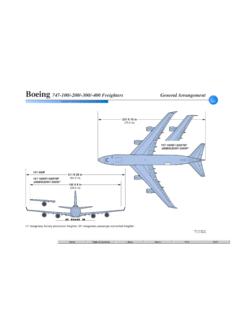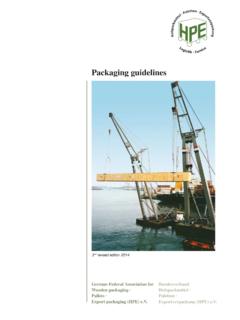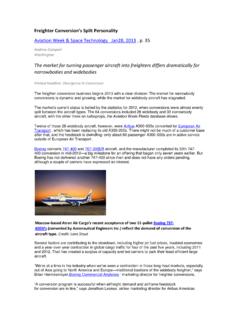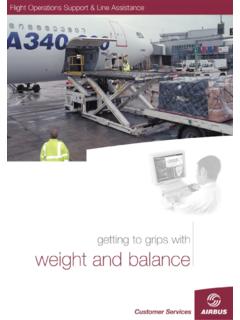Transcription of Reducing the risks associated with the manual …
1 Health and Safety Executive Reducing the risks associated with the manual handling of air passenger baggage for narrow bodied aircraft Literature review update Prepared by the Health and Safety Laboratory for the Health and Safety Executive 2009. RR674. Research Report Health and Safety Executive Reducing the risks associated with the manual handling of air passenger baggage for narrow bodied aircraft Literature review update David Riley Health and Safety Laboratory Harpur Hill Buxton Derbyshire SK17 9JN. This report is an update of the review for ramp-based baggage handling related literature undertaken in 2005 (Tapley and Riley, 2005). The aim of this review is to present information relating to alternative methods of loading narrow- bodied aircraft that reduce the manual handling related injury and ill-health risks to the handlers, and to identify knowledge gaps. This was used to inform subsequent work at East Midlands Airport in 2007/2008 (Musculoskeletal ill- health risks for Airport Baggage Handlers: Report on a stakeholder project at East Midlands Airport - RR675).
2 This report and the work it describes were funded by the Health and Safety Executive (HSE). Its contents, including any opinions and/or conclusions expressed, are those of the author alone and do not necessarily reflect HSE policy. HSE Books Crown copyright 2009. First published 2009. All rights reserved. No part of this publication may be reproduced, stored in a retrieval system, or transmitted in any form or by any means (electronic, mechanical, photocopying, recording or otherwise) without the prior written permission of the copyright owner. Applications for reproduction should be made in writing to: Licensing Division, Her Majesty's Stationery Office, St Clements House, 2-16 Colegate, Norwich NR3 1BQ. or by e-mail to ii CONTENTS. 1 1. 1. Background .. 1. 2 FINDINGS .. 3. Load weight considerations .. 3. Belt loader 5. An alternative stacking 6. Mechanical aids .. 6. Moving hold floor systems .. 7 RTT 8 Rampsnake .. 10 Powerstow .. 11 NMC Wollard Mongoose.
3 12 Mallaghan LBT90 .. 13 Bulk baggage 14 The effect of handling while 15 Other notable 15 Training and back belts .. 15 Resting laying down .. 15 Fundamental change to the process .. 15. 3 17. 4 KNOWLEDGE GAPS AND RECOMMENDATIONS FOR FURTHER 19. The practicalities of using technical aids in relation to aircraft types typically encountered by GB based baggage handlers .. 19. Baggage item weight frequency distribution .. 19. Effectiveness of the Mallaghan LBT90 .. 19. Baggage stacking methods .. 19. 5 21. iii iv EXECUTIVE SUMMARY. Objectives This report is an update of the review for ramp-based baggage handling related literature undertaken in 2005 (Tapley and Riley, 2005). The aim of this review is to present information relating to alternative methods of loading narrow-bodied aircraft that reduce the manual handling related injury and ill-health risks to the handlers, and to identify knowledge gaps. This is to inform subsequent work at East Midlands Airport in 2007/2008 (Musculoskeletal ill-health risks for Airport Baggage Handlers: Report on a stakeholder project at East Midlands Airport - ERG/08/15).
4 Main Findings We have good information concerning the range of risks to musculoskeletal health presented by ramp-based manual baggage handling operations for Boeing 737 series and Airbus A 319. aircraft. We do not have observational evidence of the range of other aircraft types that typically require bulk loading of hold baggage and the methods used. Introducing an international single item baggage weight limit of between 23 kg to 25 kg is a step that would have a positive effect in Reducing the risk of handling related injury or ill-health to baggage handling workers, by eliminating the bags above this weight level that present the greatest risk. However, it appears that such a measure may not have a large effect on the average weight of items handled. It is difficult to quantify the likely amount of risk reduction. It will not mean that the injury and ill-health risks associated with manual loading and unloading of baggage is automatically at an acceptable level.
5 At present there is relatively little information available concerning the nature of the baggage item weight frequency distribution. We understand that the frequency distribution for item weight is likely to vary according to the carrier, airport, route, time of year, etc., but without this information it is difficult for anyone to make truly representative risk assessments for baggage handling operations. There is a range of existing and emerging devices providing mechanical assistance (and manual handling risk reduction), to the baggage handling process. These include both Ground Support Equipment, and in-hold systems, and combinations of both. There is good evidence for the benefit of mechanical assistance devices in terms of Reducing physical workload, manual handling and MSD risks associated with baggage handling work on the ramp, and these are described in relation to each equipment type. We need to analyse suitable footage of the Mallaghan LBT90 in operation in order to be able to make a comparison of the postures adopted with those for standard belt loader use.
6 A suggested approach is to use OWAS to enable comparison with reported studies. Benefits of an alternative baggage stacking method are reported. This appears to offer significant advantages in terms of Reducing spinal loading. It is envisaged that the approach may be applicable in a limited set of circumstances, and for a proportion of any baggage load, but nonetheless the benefits are there, and if the approach can be adopted to any extent during loading activities, this will be beneficial. An alternative baggage stacking method appears to be a practicable means of Reducing the risks . Recommendations Further work is required to gather data on the range of aircraft typically encountered in order to better understand the practicalities and realities of using belt loaders and other risk reduction measures. v The applicability of emerging technology to assist with baggage handling , particularly in the GB low-cost sector needs to be investigated.
7 Access to baggage item weight data is required, and industry cooperation will be needed in order to gather this. A postural analysis of Mallaghan LBT90 use needs to be undertaken (and this was undertaken at East Midlands Airport). Investigate the practicalities of using an alternative baggage item stacking method in operational conditions, and the extent to which it can be adopted. vi 1 INTRODUCTION. AIMS. This report presents the findings of an update to the review for ramp-based baggage handling related literature undertaken in 2005 (Tapley and Riley, 2005). A particular aim of this review was to identify information relating to alternative methods of loading narrow-bodied aircraft that are intended to reduce the risks of the handlers suffering from musculoskeletal disorders, and to identify knowledge gaps. This information has relevance to the handlers providing services to the budget airlines serving British (GB) regional airports. The definition of narrow-bodied here is taken as that presented by Dell (2007): Single aisle passenger transport aircraft such as the Boeing B717, B727, B737, McDonnell Douglas DC9, MD83 and MD87 and Fokker F28 & F100, as well as all commuter aircraft, seating up to around 150 passengers, that are designed to have the baggage loaded in bulk, one item of baggage at a time.
8 Although some of the aircraft types included in Dell's definition are not typical in GB, especially in the low-cost sector where most bulk (or loose) loading of aircraft is still performed, the Boeing 737 series and Fokker F series aircraft certainly are. We need to include the Airbus 320 family of aircraft (A318, A319, A320 and A321) within our definition as well as some others that meet the single aisle criteria. An alternative description of this group of aircraft would be regional airliners'. We also include the Boeing 757 family of aircraft as these are common in the low-cost sector and are routinely bulk loaded with passenger baggage at regional airports. A 757-200 can seat over 220 passengers. This report was originally drafted in May 2007, however, it was agreed to keep it as a working draft' in order to capture further information and developments to inform a concurrent project in association with stakeholders at East Midlands Airport, and ending in 2008.
9 This report therefore has a 2007 reference number, but was not issued until 2008. BACKGROUND. Relatively little new information was identified through searching the Ergonomics Abstracts online database. The search terms used were: manual handling ' combined with baggage'. aircraft' and aviation'. This returned 23 articles, and these abstracts were reviewed to select ten for full text review. Other grey' literature has been included, much provided through personal communication, both with colleagues working in this sector within HSE and with external contacts. The principal source identified in this study is the review presented by Dell (2007) in his Doctoral Thesis (obtained by personal communication, Ballarat University). Dell's work represents the definitive review of baggage handling operations to date, and covers the work conducted in this area since the 1970's. There is still relatively little in the way of published material, although there is now more than there was available even as late as the 1990's.
10 Dell reports there being nine research papers specifically concerning manual baggage handling operations (generally) during his initial work towards his PhD in 1994. By 2005, Duignan (2005) reports there being less than 30 English language papers on the subject. Of the nine papers referred to by Dell (2007), several were evaluations of mechanical assistance devices: x Jorgensen (1987) - the benefits of an ACE' loading system x Stokholm (1988) the benefits of the Sliding Carpet Loading System x Egeskov (1992) the benefits of using a belt loader to load Boeing 737 series aircraft. 1. Two further papers reported the results of investigations of different working methods for in- hold handlers: x Stalhammar et al (1986) and Leskinen et al (1991) both studied the back injury prevention benefits of handlers resting supine during in-hold working. Dell's (2007) thesis addresses the following questions: x What is the scale and importance of the problem worldwide?














